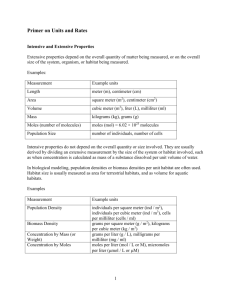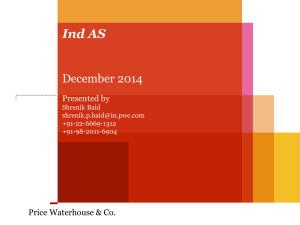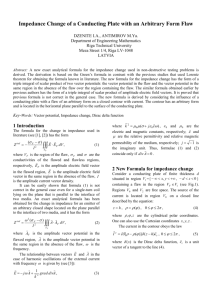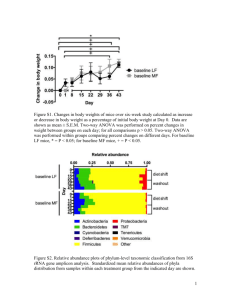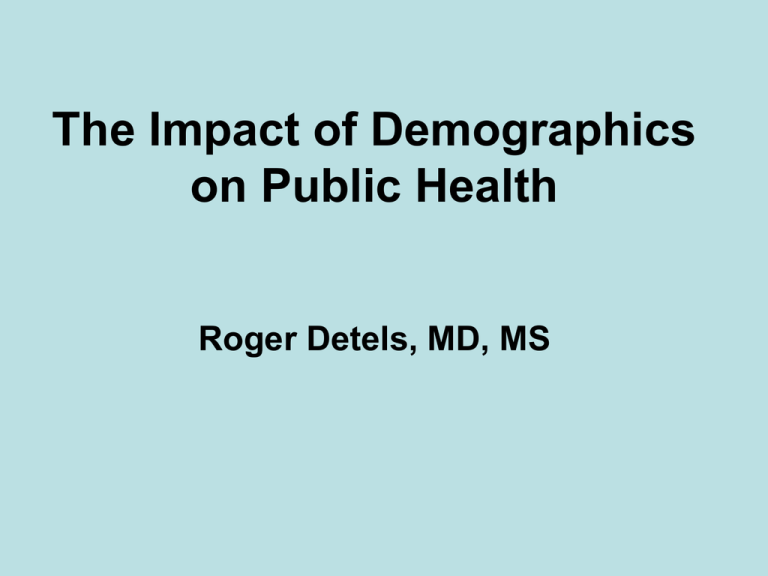
The Impact of Demographics
on Public Health
Roger Detels, MD, MS
Demography: The study of
populations, especially with
reference to size and density,
fertility, mortality, growth, age,
distribution, migration, vital
statistics and the interaction of
these with social and economic
conditions.
Last, JM. A Dictionary of Epidemiology
World Demographics Profile (1)
Population: 6,928,198,253 (July 2011 est.)
Age structure
0-14 years: 26.3% (male 944,987,919/female 884,268,378)
15-64 years: 65.9% (male 2,234,860,865/female 2,187,838,153)
65 years and over: 7.9% (male 227,164,176/female 289,048,221)
(2011 est.)
Median age
Total: 28.4 years
Male: 27.7 years
Female: 29 years (2009 est.)
World Demographics Profile (2)
Population growth rate
1.092% (2011 est.)
Birth rate
19.15 births/1,000 population (2011 est.)
Death rate
8.12 deaths/1,000 population (July 2011 est.)
World Demographics Profile (3)
Sex ratio
At birth: 1.07 male(s)/female
Under 15 years of age: 1.07 male(s)/female
15-64 years: 1.02 male(s)/female
65 years and over: 0.79 male(s)/female
Total population: 1.01 male(s)/female (2011 est.)
Infant mortality rate
Total: 41.61 deaths/1,000 live births
Male: 43.52 deaths/1,000 live births
Female: 39.55 deaths/1,000 live births (2011 est.)
World Demographics Profile (4)
Life expectancy at birth
Total population: 67.07 years
Male: 65.21 years
Female: 69.05 years (2011 est.)
Total fertility rate: 2.46 children born/woman (2011 est.)
Religions
Christian 33.35% (of which Roman Catholic 16.83%, Protestant
6.08%, Orthodox 4.03%, Anglican 1.26%), Muslim 22.43%, Hindu
13.78%, Buddhist 7.13%, Sikh 0.36%, Jewish 0.21%, Baha'i
0.11%, other religions 11.17%, non-religious 9.42%, atheists
2.04% (2009 est.)
World Demographics Profile (5)
Languages
Mandarin Chinese 12.44%, Spanish 4.85%, English 4.83%, Arabic
3.25%, Hindi 2.68%, Bengali 2.66%, Portuguese 2.62%, Russian
2.12%, Japanese 1.8%, Standard German 1.33%, Javanese
1.25% (2009 est.)
(Percents are for "first language" speakers only; the six UN languages Arabic, Chinese (Mandarin), English, French, Spanish (Castilian), and
Russian - are the mother tongue or second language of about half of the
world's population, and are the official languages in more than half the
states in the world)
World Demographics Profile (6)
Literacy (definition: age 15 and over can read and write)
Total population, 83.7%; male, 88.3%; female: 79.2%
(Over 2/3rd of the world's 793 million illiterate adults are found in
only eight countries (Bangladesh, China, Egypt, Ethiopia, India,
Indonesia, Nigeria, Pakistan); of all the illiterate adults in the
world, 2/3rd are women)
School life expectancy (primary to tertiary education):
Total, 11 years; male, 11 years; female, 11 years (2008)
Education expenditures: 4.4% of GDP (2007)
World population distribution, 2011
http://www.globalhealthfacts.org/data/topic/map.aspx?ind=79
Males
Females
World population/age pyramid, 2010 (6,908,689,000 total)
http://populationpyramid.net/?country=World&year=2010
Population/Age Pyramids of the Developed vs Developing World
http://www.globalchange.umich.edu/globalchange2/current/lectures/human_pop/human_pop.html
Population
pyramids for
developing vs
developed
countries;
projections of
worker per older
adult
Science 333:542-3, 2011
Percent of population under the age of 15 years, 2010
http://www.globalhealthfacts.org/data/topic/map.aspx?ind=82
The majority of population growth occurs in developing countries
Science 333:542, 2011
Total fertility rate (children per woman), 2011
http://www.globalhealthfacts.org/data/topic/map.aspx?ind=87
Association of education and poverty with fertility
Science 333:541, 2011
Science 333:541, 2011
Population growth, historic and projected, and trends in life expectancy
Science 333:540, 2011
Global Aging
% >60 years old: 10% in 2000
21+% in 2015
Effect of Aging: <60 versus >60 years:
Health care use 3- to 5-fold greater
50% have two or more chronic conditions
Proportion of population 60 years or older: world, 1950-2050
http://www.un.org/esa/population/publications/worldageing19502050/pdf/62executivesummary_english.pdf
Population in developing vs developed countries
Science 333:543, 2011
http://www.global
healthfacts.org/da
ta/topic/map.aspx
?ind=83
Percent of population living in urban areas, 2010
Urban population: 50.5% of total population (2010)
Rate of urbanization: 1.85% annual rate of change (2010-15 est.)
10 largest urban agglomerations: Tokyo (Japan) - 36,669,000; Delhi (India) - 22,157,000; Sao
Paulo (Brazil) - 20,262,000; Mumbai (India) - 20,041,000; Mexico City (Mexico) - 19,460,000; New
York-Newark (US) - 19,425,000; Shanghai (China) - 16,575,000; Kolkata (India) - 15,552,000; Dhaka
(Bangladesh) - 14,648,000; Karachi (Pakistan) - 13,125,000 (2009)
Rural vs. Urban
• Poorer health
• Less access to health care
• Poorer quality of health care
• Higher proportion of elderly, due to industrialization and
requisite migration to urban areas
• Slower epidemic potential (population density), but lower
rates of immunity
• Higher cost of providing services; e.g., water, electricity, waste
disposal
Percent of Poor Households with Access to Services (continued)
http://www.prb.org/pdf09/64.2urbanization.pdf
Impact of Poor Water and
Sanitation
• Causes 88% of diarrhea cases; 1.5 million deaths annually
• High infant mortality due to dehydration resulting from
diarrhea
• No access to improved water – 884 million (13% of the
global population)
Percentages of population with sustainable access to an improved water
source, 2008
http://www.globalhealthfacts.org/data/topic/map.aspx?ind=44
Percent of population with access to improved sanitation, 2008
http://www.globalhealthfacts.org/data/topic/map.aspx?ind=45
http://gamapserver.who.int/mapLibrary/Files/Maps/global_cholera_cases_2009.jpg
Death rate (deaths per 1000 population), 2011
http://www.globalhealthfacts.org/data/topic/map.aspx?ind=90
Child mortality (deaths under the age of five years per 1000 live births), 2009
http://www.globalhealthfacts.org/data/topic/map.aspx?ind=94
Maternal mortality (adjusted per 100,000 live births), 2008
http://www.globalhealthfacts.org/data/topic/map.aspx?ind=95
Female life expectancy at birth (years), 2008
http://www.globalhealthfacts.org/data/topic/map.aspx?ind=97
Male life expectancy at birth (years), 2008
http://www.globalhealthfacts.org/data/topic/map.aspx?ind=96
GDP per capita, 2009
http://www.globalhealthfacts.org/data/topic/map.aspx?ind=99
Percent of population living on less than $1.25/day (varying years of data availability)
http://www.globalhealthfacts.org/data/topic/map.aspx?ind=100
Poverty
Globally, 1.2 billion (17.4%) of the world’s population live on
<$US1 per day
Poor versus rich countries:
• Deaths of children under 5 years of age: 20:1
• Malnutrition: 10:1
• Life expectancy: -16 years
• Internal country disparities (e.g. 39.8 million Americans live
below the poverty level; >20% among Hispanics and
African-Americans
Prevalence of undernourished (underweight) children (<5 yrs), 2000-2009
http://www.globalhealthfacts.org/data/topic/map.aspx?ind=48
Some Conclusions from
Demographic Studies (1)
• The majority of the world’s population lives
in developing countries
• Although fertility is declining, increases in
population will occur primarily in developing
countries in coming decades
• Developed countries must cope with a
shrinking productive age population and a
burgeoning elderly population
• The majority of the global population will
live in urban areas in coming decades
Some Conclusions from
Demographic Studies (2)
• The world’s wealth is concentrated in a
minority of countries
• Poor sanitation and hunger are
concentrated primarily in countries in subSaharan Africa and South Asia
• Population density (which promotes
emerging diseases) is greatest in
developing countries, particularly China and
India
• Global inequity remains a major problem









